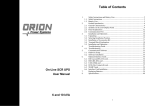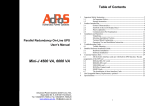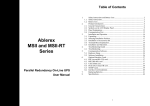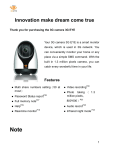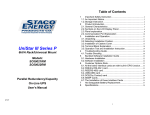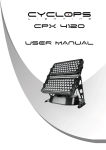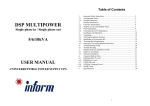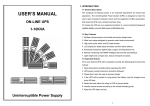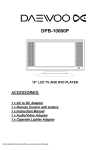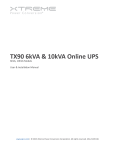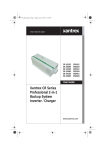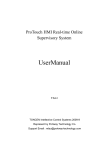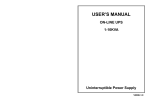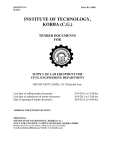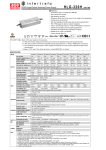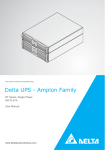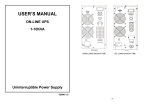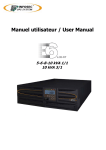Download MSII 6K ENGLISH NEUTRAL user manual
Transcript
Table of Contents 1. 2. 3. 4. 5. 6. Parallel Redundancy On-Line UPS User’s Manual 7. 8. Important Safety Instruction ............................................................................. 2 1.1. An Important Notice ......................................................................................... 2 1.2. Storage Instruction............................................................................................ 4 Product Introduction ......................................................................................... 5 2.1. General Characteristics ..................................................................................... 5 2.2. Symbols on the LCD Display Panel ................................................................. 7 2.3. Panel explanation............................................................................................ 10 2.4. Communication Port Explanation................................................................... 13 Installation and Operation............................................................................... 14 3.1. Unpacking....................................................................................................... 14 3.2. Selecting Installation Position......................................................................... 15 3.3. Installation of Accessories Kit ........................................................................ 15 3.4. Terminal Block Explanation ........................................................................... 16 3.5. Operation Test and Installation Instruction..................................................... 19 Troubleshooting Guide ................................................................................... 31 4.1. Trouble Shooting ............................................................................................ 31 Bundled Software Installation Guide.............................................................. 33 5.1. Hardware Installation...................................................................................... 33 5.2. Software Installation ....................................................................................... 33 Customer Options Slots .................................................................................. 34 6.1. R2E(2nd RS-232 ) card .................................................................................. 34 6.2. RSE(RS-485) card .......................................................................................... 34 6.3. USE(USB) card .............................................................................................. 34 6.4. DCE(Dry Contact)-B card .............................................................................. 35 6.5. SNMP Cards ................................................................................................... 36 6.6. The Installation of those Interface Cards ........................................................ 37 Hot Swappable Battery Replacement ............................................................. 38 Specifications.................................................................................................. 40 6-10KVA 1 1. Important Safety Instruction 1.1.14. Dusty, corrosive and salty environments can do damage to any UPS. 1.1. An Important Notice 1.1.15. Install the UPS away from objects that give off excessive heat and areas that are excessively wet. 1.1.1. For Parallel System installation, please refer to “MSII 6KVA Parallel System Installation Guide” 1.1.2. Because of “LITTLE LEAKAGE CURRENTS” generated by the EMI filter of the UPS, it is necessary to double ensure if the earth of the UPS is properly grounded before AC Mains is connected with. 1.1.17. The battery will discharge naturally if the system is unused for any length of time. 1.1.3. To ensure safety in all applications where a UPS is hard wired to the Electrical Supply, ensure that the system is installed by a Qualified Electrical Contractor. 1.1.18. It should be recharged every 2-3 months if unused. If this is not done, then the warranty will be null and void. When installed and being used, the batteries will be automatically recharged and kept in top condition. 1.1.4. The UPS has its own internal energy source (battery). Should the battery be switched on when no AC power is available, there could be voltage at the output terminals. 1.1.19. This UPS supports electronic equipment in offices, telecommunications, process control, medical and security applications. Non-authorized technician is not allowed to install the UPS in the following areas. 1.1.5. Make sure that the AC Utility outlet is correctly grounded. 1.1.6. Do not open the case, as there are no serviceable parts inside. Your Warranty will be void. 1.1.7. Do not try to repair the unit yourself; contact your local supplier or your warranty will be void. 1.1.8. Please make sure that the input voltage of the UPS matches the supply voltage. 1.1.9. Use a certified input power cable with the correct plugs and sockets for the appropriate voltage system. 1.1.10. To eliminate any overheating of the UPS, keep all ventilation openings free from obstruction, and do not store "things" on top of the UPS. Keep the UPS 30 cm away from the wall. 1.1.11. Make sure the UPS is installed within the proper environment as specified. (0-40℃ and 0-90% non-condensing humidity) 1.1.12. Do not install the UPS in direct sunlight. Your warranty may be void if the batteries fail. 1.1.16. If liquids are split onto the UPS or foreign objects dropped into the unit, the warranty will be null and void. a. Medical equipment directly related to human life b. Elevator, Metro (Subway) system or any other equipment related to human safety. c. Public system or critical computer systems. 1.1.20. Do not install the UPS in an environment with sparks, smoke or gas. 1.1.21. Make sure the UPS is completely turned off when moving the UPS from one place to another. It might cause electrical shock if the output is not cut completely. 1.1.22. The Maintenance Bypass Switch is equipped with the UPS. Please follow the procedures strictly to switch on/off the Maintenance Bypass Switch. 1.1.23. The UPS offers CVCF (Constant Voltage Constant Frequency) setting function. a. For correct setting and wiring, please contact with your local agent. b. Do not do it by yourself; otherwise, your warranty will be void. 1.1.24. This UPS has been designed and constructed to protect your assets from the wide range of power aberrations experienced on Utility power lines today. It is your insurance for reliable, clean and stable voltage supply. It is worth taking care to install the system correctly and to have it maintained correctly by your local dealer. 1.1.13. Install the UPS indoors as it is not designed for installation outdoors. 2 3 1.1.25. SAVE THESE INSTRUCTIONS - This Manual Contains Important Instructions that should be Followed during Installation and Maintenance of the UPS and Batteries. 1.1.26. Intended for Installation in a Controlled Environment. 1.1.27. Disconnection Device-CAUTION - A disconnect switch shall be provided by others for ac output circuit. To reduce the risk of fire, connect only to a circuit provided with branch circuit over-current protection for 30 amperes for 6Kva and 40 amperes for 8Kva (10Kva See below details) rating in accordance with the National Electric Code, ANSI/NFPA 70. 10Kva tower Output rating Ratings of output branch circuit Output No. Over current protection No.1 (L21-N21) 5 KVA, 120 V 45 No.2 (L22-N22) 5 KVA, 120 V 45 No.3 (L23-N22) 10 KVA, 208 V 50 No.4 (L21-N22) 10 KVA, 240 V 45 1.1.28. CAUTION - To reduce the risk of fire, unit input connect only to a circuit provided with branch circuit over-current protection for 40 amperes for 6Kva and 50 amperes for 8Kva and 65 amperes for 10Kva amperes rating in accordance with the National Electric Code, ANSI/NFPA 70. 1.1.29. The Units are to be installed so that is not likely to be contacted by people. 2. Product Introduction 2.1. General Characteristics 2.1.1. True online architecture continuously supplies in your critical device with a stable, regulated, transient-free pure sine wave AC Power. 2.1.2. 20KHz PWM sine-wave topology yields an excellent overall performance. The high crest factor of the inverter handles all high-inrush current loads without a need to upgrade the power rating. 2.1.3. Multi-functional LCD/LED panel may display various status of the UPS. The LED display may show UPS working status, Utility Status and UPS Abnormal status, in the mean while, the LCD display may show Input/Output Voltage, Frequency, Load Status, Inner cabinet temperature, and Abnormal Phenomenon. 2.1.4. To protect the unit from overloading, it automatically switches to bypass mode in 160 seconds~ 40ms if loading is at 105%~ 150% of rating and in case of overloading at 150% of rating, it switches to bypass mode immediately. It will automatically switch back to inverter mode once overload condition ceases. 2.1.5. Should the output becomes short-circuit, the UPS holds the system and cuts the output automatically till the short circuit situation is removed manually. 2.1.6. Should the unit become overheated, the internal thermal Switch will detect the heat and switch to bypass mode and vice versa. 2.1.7. Fully digitalized control circuit built in the UPS may upgrade the functionality Of the UPS as well as reach a high-level protection of the UPS. Through powerful Communication capability built, it enhances its ability for remote control and monitoring easily. 2.1.8. Maintenance-free sealed-type battery minimizes after-sales service. 2.1.9. Maintenance bypass switch — it provides an easy and safe troubleshooting or maintenance function when the Utility is normal. 1.1.30. Maximum ambient operating temperature 40°C or equivalent 1.2. Storage Instruction For extended storage through moderate climate, the batteries should be charged for 12 hours every 3 months by plugging the UPS power cord into the wall receptacle and turn on input breaker on front panel. Repeat this procedure every 2 months under high temperature environment. 2.1.10. Providing four different working modes, such as Normal, ECO, CF50 and CF60, it may widely be used in a variety of applications. 2.1.11. DC-start function makes sure of the start-up of UPS during power outages. 4 5 2.1.12. Revolutionary battery management circuit analyzes battery discharging status to adjust battery cut-off point and extend the life of batteries. 2.1.13. Intelligent temperature-controlled fan may not only extend the life of the fan, but also reduce annoying noise because of sudden fan spin. It remains your office quiet and comfortable as usual. 2.1.14. When UPS is out of order, you may read out the possible fault reason from the LCD screen directly, which may reduce down unnecessary repair task a lot. 2.1.15. In case the UPS is out of order, Fault status will be shown on the LCD screen. 2.1.16 When the UPS is operated under CF50 or CF60 mode, the recommended load connected shall be 75% of rated capacity if the input voltage is 176~280Vac and 50% of the rated capacity if the input voltage is 160~280Vac. 2.2. Symbols on the LCD Display Panel Item Symbol Description 1 LINE Utility or Bypass Source 2 Battery Low 3 Battery Abnormal 4 UPS Overloading 5 UPS Working in specified mode* 6 A Blackout Transfer occurred in UPS Output 7 Bypass Input Abnormal, UPS fails to transfer to bypass, Bypass Abnormal at ECO mode 8 Utility Input Abnormal 9 10 6 UPS Shutoff OFF LINE OFF UPS Abnormal Lock 11 UPS Flow Chart 12 4 Digits Measurement Display 13 Indicate the item desired to be measured 14 UPS ON Switch or Alarm Silence 15 UPS OFF Switch 16 Previous Page or Setting Change 7 17 Next Page 35 Er21 Parallel communication error ( communication wire disconnected or failure to find ID1 UPS ) in parallel system 18 Special Function Log in /out 36 Er24 CVCF mode with Bypass input 19 Enter or Reconfirmed 37 Er27 The UPS must be operated in normal mode in parallel system 20 Utility Input Normal LED 38 Er28 Bypass Overload Time out and cut off output. 21 Bypass Input Normal LED 39 Er31 The settings of both control board and driver board are not matched each other. 22 UPS under Redundancy Mode 40 Er33 Isolated transformer overheat 23 UPS under ECO Mode 41 Er** Other Error code *The specified modes include Normal mode, ECO mode, CVCF mode, etc.. UPS Fault or Abnormal Warning LED 24 25 EPO Emergency Power Off 26 Er05 Battery Weak or Dead 27 Er06 Output Short Circuit 28 Er10 Inverter Over-current 29 Er11 UPS Overheat 30 Er12 UPS Output Overloading 31 Er14 Fan error 32 Er15 Wrong Procedure to enter Maintenance Mode 33 Er16 Output Parameters Set Error in Parallel System 34 Er17 ID Numbers are in conflict in Parallel System or ID number Error in single unit 8 9 2.3.2. 2.3. Panel explanation 2.3.1. Front Panel Function Explanations 1 23 4 5 6 1 7 3 4 2 Rear Panel Explanation Tower Model N E D CB A 11 12 Par allel Work Comm. Bus 6000C Model D CBA ONOFF S1 P aral lel Work Comm. B us Not Inten ded to TN V C ommunic ati o n Netwo rk RS232 RS232 Not I ntended to TNV Communic ation Network Slot 8 N EPO Slot 2(CHB) 9 11 F F J 12 G EPO SNMP Adapter Only I 10 Slot 1(C HA) G - + Ex t. Battery CB 2 Bypass I nput Br eaker CB 1 Utilit y Input Br eaker SW 1 Manual By pass 5 9 7 10 6 8 Utility Input Break er K LCD Display I INV L Ex ternal Battery Green LED lights up to indicate the UPS has the capability to run under G + redundancy mode. G OUTPUT INP UT G2 N22 L21 G1 N1 L12 L External Charger L2 1- N 2 2: U P S O U T P U T L1 2- N 1 : U TI L IT Y IN P U T G 2 : O U T PU T EA R T H G 1 : I N PU T E A RT H GROUND G R O U ND G + P H P A T. N O . : U S 69 06 501 , T W 2 026 68 Green LED steadily lights up to indicate that the Utility input voltage is within the window; the LED flashes flickeringly to indicate that the Utility input voltage is within the acceptable window. PAT. N O.: US 6906501, TW 202668 Also available for Rack O Normal Trip P Green LED lights up to indicate Bypass Input is normal. UPS ON/Alarm Silence Go to previous page or change the setting of the UPS. M To re-confirm the change of UPS Setting RT 10K G Go to next page UPS OFF Switch I J P N A B C Special functions log in/out D UPS is working under ECO(Economic) mode. F BA N UPS Fault or Abnormal C G 10 RT 6K F 11 P L L I D E A B C D E F G H I J K L M N O RS232 Port Terminal Resistor for Parallel function CAN Bus Connection Port for Parallel System Customer Options Slot 1 Customer Options Slot 2 Cooling Fan External Battery Connector External Charger Connector Utility Input Breaker CB1 Bypass Input Breaker CB2 (for Dual Input Model Only) CAM Switch(Maintenance Bypass Switch) Input/Output Terminal Block Fixing Holes for External Charger Cabinet EPO(Emergency Power Off): Short to enable the function Thermal breaker for the protection of Load in abnormal condition: CB3 P Air Ventilation Hole ● . DIM:Dual Input Model, SIM:Single Input Model 2.4. Communication Port Explanation The Communication port on the UPS provides true RS232 type to communicate with UPS software to remote monitoring the power and UPS status. With optional interfaces cards, which contains R2E(2nd RS232), RSE(RS485), USE(USB), DCE(Dry Contact), as well as SNMP/ card, you may combine them according to your demand. However, the R2E card, RSE card and USE card are prohibited to be used Simultaneously. The bundled software of the UPS is compatible with many operating systems such as Windows 98, & 2000, ME, NT and XP. For other applications like Novell, NetWare, Unix, Linux, please contact your local distributor for a proper solution. When the optional interface cards are used together with onboard RS232 port in communication, the EPO signals will get the highest priority in control command, then the SNMP/WEB card , then the shutdown command at the DCE card & also R2E, RSE and USE, then onboard RS232 port get the lowest priority. 2.4.1. True RS232 type 2.4.1.1. The RS232 interface settings The RS232 interface shall be set as follows: Baud Rate 2400 bps Data Length 8 bits Stop Bit 1 bit Parity None 2.4.1.2. The Pin Assignments of true RS232 type The Pin Assignments of true RS232 type are illustrated as follows: 9 8 7 6 12 5 4 3 2 1 Pin 3: RS232 Rx Pin 2: RS232 Tx Pin 5: Ground 13 3. Installation and Operation 3.2. Selecting Installation Position The packing condition and the external outlook of the unit should be inspected carefully before installation. Retain the packing material for future use. 3.1. Unpacking 3.1.1. 3.1.2. 3.1.3. Take the UPS out of the PE foam. Unwrap the UPS. Standard Package includes: ¾ 1 set of Quick Start Manual ¾ 1 set of User's Manual ¾ 1 set of UPS communication software with RS232 cable ¾ 1 set of Metal Accessories Kit for Tower model or RT model as below: 3.1.4. Package for the UPS with Isolation transformer & dual input: ¾ Ditto, but with additional 3pcs wire No 7. 3.1.5. Package for the UPS without isolation transformer but dual input: ¾ Ditto, but with additional 1pcs wire No. 7. (p.s. Wire No. 7 is to be used at the input/output terminal block of the UPS. Please refer to Chapter 3.4 for installation. It is necessary to select a proper environment to install the unit, in order to minimize the possibility of damage to the UPS and extend the life of the UPS. Please follow the advice below: 1. Keep at least 30cm (12 inches) clearance from the rear panel of the UPS to the wall. 2. Do not block the air-flow to the ventilation openings of the unit. 0℃ 40℃ 3. Please check the installation site to avoid overheat and excessive moisture. 4. Do not place the UPS in an environment near dust, corruptive or salty material or flammable objects. 5. Do not expose the UPS to outdoors. Tower model 3.3. Installation of Accessories Kit RT model B1 A1 A2 A3 x4 x4 x1 B2 B3 B4 S3 for 2U x2 Relative humidly (non condensation) 30% ~ 90% for 3U for 4U x2 x2 S1 S2 S3 S4 x2 x4 x8 x6 x2 S3 S3 RT10K only B1 B2 S4 A1 X1 B1 B3 S4 A2 X1 A3 X2 14 15 3.4. Terminal Block Explanation L11-N1、B-N1: the terminal for Bypass Input to provide the power source when the UPS is working under bypass mode. ● L12-N1、R-S-T-N1: the terminal for Utility Input to provide the power source when the UPS is working under Utility mode. ● G1: the terminal for UPS Input Ground. ● L21、L23、N21、L22、N22: the terminals for UPS Output. ● G2: the terminal for UPS Output Ground. ● Tower model OUTPUT INPUT BYPASS INPUT G2 N22 L22 N21 L23 L21 G1 N1 (DIM TYPE ONLY) L12 L11 UTILITY INPUT N22, L22, N21, L23, L21: UPS OUTPUT G2 : OUTPUT EARTH GROUND L11-N1: BYPASS INPUT (DIM TYPE ONLY) L12-N1: UTILITY INPUT G1 : INPUT EARTH GROUND Remarks: 1. The maximum current for each terminal is 30Arms for 6Kva, 50Arms for 10Kva. 2. If the UPS is DIM(Dual Input) type whose Utility and Bypass Sources are the same, L11 and L12 would have to be shorted for 1-phase input model, and short B and R for 3-phase input model. 3. If the UPS is SIM(Single Input) type, only AC source can be supplied to UPS from L12-N1 terminal for 1-phase input model and R-S-T-N1 terminal for 3phase input model. 4. When the Isolation transformer is NOT installed into the tower type UPS, the UPS output terminals will be L22-N22.. 5. When the Isolation transformer is installed into the tower type UPS: a. For 100/110/115/120Vac system, you may connect as shown in below. 6000C or RT6K model N22 N21 L23 L21 110Vac 6KVA (Max) RT10K model b. For 200/100Vac, 220/110Vac, 230V/115Vac, or 240/120Vac, or 240/208/120Vac system, You may connect as shown in below. TB1 TB1 L22 208Vac 6KVA (Max) TB2 TB2 N22 L22 N21 192408SN0000400 L21 120Vac 3KVA (Max) 120Vac 3KVA (Max) 240Vac 6KVA (Max) 16 L23 17 ● 3.5. Operation Test and Installation Instruction Use Mounting Cable Tie to fix cables. 3.5.1. Tower model 6000C model 6KRT model External Battery External Charger T1 10KRT model Start Up in Normal Mode 3.5.1.1. Open the terminal block cover on the rear panel (refer to 2.3.2) Before start the installation, please make sure the grounding is connected properly. 3.5.1.2. Make sure Utility breaker, UPS’ Utility breaker and Bypass breaker are On “Off” position. 3.5.1.3. Make sure the voltage of Utility matches with the input voltage window of the UPS. 3.5.1.4. Connect the Utility separately to the terminal blocks of UPS’ Utility and Bypass Inputs. Switch on the Power Breaker of the distribution panel and the breakers of the UPS’ Utility and Bypass & light Inputs, and then the UPS starts up. Green LEDs up to show the Utility and Bypass Inputs are normal and the LCD display with parallel function will illustrate from drawing A1, drawing A2 to drawing B. Otherwise the LCD display will illustrate from drawing A2 to drawing B. A1. 6. Please refer to the specs of input current, output current and recommended conductors listed as below : a. AC input and output (75°C minimum copper wire) Model Maximum Current Conductor Section 4.5KVA 25A AWG #10 6KVA 33A AWG #9 8KVA 43.4A AWG #8 23 lb-in 10KVA 54.3A AWG #6 23 lb-in b. Battery input Torque force A2. B. Model Maximum Current Conductor Section 4.5KVA 19A AWG #10 6KVA 25A AWG #10 8KVA 33A AWG #10 10KVA 41A AWG #10 18 19 3.5.1.5. Then, the UPS is on Bypass Mode now and it will proceed selftest automatically. If there is no abnormal message occurred, it means the pre-startup of the UPS is successful and the charger starts to charge the batteries. F for approx. 3 seconds, then the 3.5.1.6. Press the UPS On Switch Buzzer sounds twice and the LCD display changes from drawing B to drawing C. * It shows “220Vac” in Utility Input. 3.5.1.8. In case of failure in self-test, the LCD display will illustrate from Drawing D to drawing E2, then an error code or error status will be shown on the screen. 3.5.1.9. Your start-up operation of the UPS is completely now. Make sure the UPS is plugged onto the wall receptacle for charging at least 8 hours and the batteries of the UPS are fully charged. C 3.5.1.7. Then, the UPS is under self-test mode again, the LCD display will illustrate from drawing C to drawing D and remain approx. 4 seconds under battery mode, then illustrate from drawing E1 to drawing F if the self-test is successful. 3.5.2. Start-up in Battery Mode (Cold Start) 3.5.2.1. Make sure the UPS you have has already been installed at least 1 set(20pcs) of 12V/7AH batteries. once for approx. 5 seconds to 3.5.2.2. Push the UPS On Switch awake the UPS, and then the buzzer sounds twice. The LCD display will illustrate from drawing A to drawing G, and keep awake for approx. 15 seconds. D of the UPS again for about 3 3.5.2.3. Press the UPS On Switch seconds till the LCD display illustrates from drawing G to drawing H, then the UPS will be in self-test Mode. The UPS may offer energy to the output in a minute, and the LCD display illustrates as drawing I. In case of failure in pushing the UPS On Switch within 15 seconds, the UPS will automatically turn off. You then have to go through step 3.5.2.1 to 3.5.2.3 once again. 3.5.2.4. * It shows “test”. E1 * It shows “OK” in self-test G E2 z It shows “Off”, which means the UPS pre-start is successful. * It shows “Fail” in self-test 20 21 H J * It shows Utility input is “0” and Utility Abnormal. I * It shows frequency from Utility Input. K * It shows frequency from Bypass Input. 3.5.3. Check Measured Values & Figures detected by UPS 3.5.3.1. If you would like to check the measured values & figures detected and scroll down key by the UPS, please use scroll up pads. When you use scroll down key pad, the LCD display will illustrate as Drawing C(Voltage from Utility Input) ÆDrawing I1(Voltage from Bypass Input) Æ Drawing J(Frequency from Utility Input) ÆDrawing K(Frequency from Bypass Input) ÆDrawing L(UPS Output Voltage) ÆDrawing M(UPS Output Frequency) ÆDrawing N(UPS Output Load %)ÆDrawing O(UPS Battery Voltage) ÆDrawing P(UPS Inner Temperature). L * It shows UPS output Voltage. M I1 * It shows UPS output frequency. * It shows voltage comes from Bypass Input N * It shows UPS output load level(%) 22 23 3.5.4.2. Press key pad to scroll down the screen and check the UPS settings. The LCD display will show in consequence between Drawing Q1(buzzer) Æ Drawing R1(Self-test) ÆDrawing S1(Bypass Voltage Windows) Æ Drawing T(Output Frequency Synchronization Window) ÆDrawing U(Inverter Output Voltage) ÆDrawing V1(UPS Operation Mode) ÆDrawing W(Output Voltage Micro Tune Value) ÆDrawing X(UPS Id) ÆDrawing Y(Parallel function status). O * It shows Battery Voltage. R1 P * It shows self-test is NOT “on”. * It shows UPS Inner Temperature 3.5.4. UPS Default Data and Special Function Execution 3.5.4.1. After UPS completely starts up, press LCD display screen to drawing Q1. key pad to change the R2 * It shows self-test is “On”. Q1 S1 * It shows buzzer “On”. * It shows Bypass Voltage is adjusted to narrow one. Q2 S2 * It shows buzzer “Off”. * It shows bypass voltage is adjusted to wider one. 24 25 V4 T * It shows the UPS is operated in “CVCF 60Hz mode”. * It shows Frequency Window is +/-3Hz. W U * It shows Output Voltage Adjustment % from 0% to 3% or -0% to -3%. * It shows inverter output voltage. X V1 * It shows UPS Identification Number. * It shows the UPS is operated in “normal mode”. Y V2 * It shows the UPS is operated in “Eco mode”. V3 * It shows the UPS is operated in “CVCF 50Hz mode”. 26 st * It shows the UPS is in the No. 1 of parallel systems. key pad, you may execute special functions. 3.5.4.3. Press scroll up The Functions includes buzzer ON (as drawing Q1), or buzzer OFF (as drawing Q2, Alarm silence for UPS Warning) and selftest OFF (As drawing R1) or self-test ON. (as drawing R2. UPS will execute battery test for 10 seconds. If the self-test is successful, it will show as Drawing E1; otherwise, it will show as drawing E2 & error message in the same time.) 27 3.5.5. 3.5.4.4. UPS Default Settings and their alternatives 3.5.5.1. Make sure the UPS is not “On” yet. Press On Switch and AA key pads simultaneously for approx. 3 seconds, scroll down the buzzer will sound twice, the LCD display screen shows as drawing Q1, then the UPS is under setting mode now. 3.5.5.2. To scroll down the LCD screen, you may refer to Chapter 3.5.4.2 3.5.5.3. Except Buzzer(as drawing Q1 & Q2) and Self-test(as drawings R1 & R2), all the rest default settings may be changed by key pad. pressing scroll up 3.5.5.4. Drawings S1 and S2 mean the bypass input acceptable window, it can be 184Vac~260Vac or 195Vac~260Vac. 3.5.5.5. Drawing T means the bypass frequency window of the Inverter Output, the acceptable setting values are ±3Hz and ±1Hz. 3.5.5.6. Drawing U means the acceptable Inverter Output Voltage, of which voltage is 200Vac, 208Vac, 220Vac, 230Vac, or 240Vac. 3.5.5.7. Drawing V1, V2, V3 and V4 mean the operation modes of the UPS, of which alternative is Online, Eco(Economic) mode, fixed 50Hz Output or fixed 60Hz Output. 3.5.5.8. Drawing W means the adjustments of the Inverter Output, which may be calibrated as 0%, +1%, -1%, +2%, -2%, +3%, or -3%. 3.5.5.9. Drawing X means a specified address & position of the UPS when the UPS is in Parallel mode. The settable numbers are from 1st to 4th. The number must be 1st if the UPS is not in parallel. 3.5.5.10. Drawing Y means the parallel function status. The “P 01” means parallel function disabled and the “P 02” means parallel function enabled. 3.5.5.11. When all the setting changes are done, you have to press enter * It shows the UPS is locked. 3.5.5.12. Turn Off the breaker of Utility Input. 3.5.5.13. Your Setting changes are complete. 3.5.6. UPS Is Off Due to Unknown Reason and Its Trouble Shooting 3.5.6.1. If there is a serious abnormal condition occurred, the UPS will lock it itself in “OFF” position as shown in drawing AA and a abnormal message will show on the LCD screen. 3.5.6.2. After 3 seconds, all messages will be locked except Bypass & LCD ). In case the Utility is messages(LED abnormal after the UPS is locked, the LED will be extinguished and the LCD will be shown on the LCD screen. 3.5.6.3. To release the UPS lock, please proceed the followings: 3.5.6.3.1. Check those error messages recorded. 3.5.6.3.2. Check to see Chapter 2.2 to trouble shoot the problem of the UPS. Otherwise, consult your local distributor for service. key pad for 5 seconds and buzzer will sound twice. 3.5.6.3.3. Press Off 3.5.6.3.4. Turn Off the Breaker of Utility Input. 3.5.6.3.5. The UPS lock problem is solved now, but you shall contact with your Local distributor to make sure the error message shown is solved. 3.5.7. key Pad to save all the changes when the LCD screen shows as drawing Z, then, the LCD screen will show as drawing AA to complete the setting changes. If you don’t want to change those Shut Off key pad for about 5 seconds, the Inverter output 3.5.7.1. Press Off will be turned off, then the output load is supplied by Bypass loop and the LCD screen shows as drawing B. 3.5.7.2. Turn Off the breakers of Utility and Bypass Input. 3.5.7.3. The UPS is turned off completely. key pads for 5 seconds, then settings, you may press “OFF” the LCD screen turns to Drawing AA directly, which means your setting changes are invalid. 3.5.8. Maintenance Bypass Mode Z * Please press Enter key to save data. 28 29 3.5.8.1. It is for UPS maintenance only. A Non-authorized technician is not allowed to operate the following procedures. If there is any damage under unauthorized condition, your warranty will be void immediately. key pad for approx. 5 seconds, the LCD screen 3.5.8.1.1. Press the Off shows as drawing B and the UPS output is on bypass mode. 3.5.8.1.2. Release the cover of the CAM Switch(Maintenance Bypass Switch) first, then turn on the CAM Switch to “Bypass” mode, and at the rightsign. hand upper Corner of the LCD screen will show 3.5.8.1.3. Turn off the UPS Utility breaker as well as Bypass Input Breaker, you then may proceed UPS maintenance now. 3.5.8.1.4. To repeat 3.5.1.4, you may put the UPS back to normal working mode, then turn back the CAM switch to “INV” mode, fasten back the cover and repeat 3.5.1.5 to 3.5.1.8 The UPS will switch back to inverter mode. 3.5.8.1.5. It is required to go through 3.5.8.1.1 first, then go through 3.5.8.1.2 If you skip 3.5.8.1.1, the UPS will alert for 10 seconds to warn that the procedure is abnormal, which may damage the UPS due to uncertain utility status. The UPS will switch back to Inverter mode immediately if you turn the CAM switch back to “INV”. 30 4. Troubleshooting Guide 4.1. Trouble Shooting When the UPS malfunctions during operation, you may check the followings: a. Are the wirings of input and output correct? b. If the input voltage of the Utility is within the input window of the UPS? In case problems or symptoms still exist, please proceed the followings for proper adjustment. Should the problem persists, please contact your local distributor for help. 31 5. Bundled Software Installation Guide Situation Check Items Solution UPS Red Fault Check the error code 1. Check to see if the battery connection is LED lights up shown on the LCD screen properly done, then re-charge the batteries for 8 hours to see whether the UPS may backup normally; otherwise, & 1.Er05, 2.Er06, Er10, Er12 Er28 & consult your local distributor right away. 2. If the CB3 is tripped, please turn off the UPS completely and keep the CAM 3.EPO switch at position INV before pressing 4.Er11, Er33 CB3. Then remove some uncritical load 5.Er14 at the UPS output end. If any damage of 6.Er15 the coating of AC power cord, please 7.Er16, Er27 replace a new one. 8.Er21 3. Remove the short circuit occurred at the 9.Er24 EPO terminal. 10. other error code 4. Remove the objects blocked onto the ventilation holes. 5. Check the cooling fans on rear panel are working normally. 6. Make sure the UPS is operated normally. If it is on CVCF mode, you have to turn off and turn on the UPS again. 7. All of parameters except ID Number in the parallel UPS must be same. Please refer chapter 3.5.5 to set them again 8. Reconnect the RJ-45 wire or set a UPS with ID=1. 9. When the UPS is on CVCF mode, it is prohibited to have bypass input. You have to turn off the UPS and bypass input and re-start the UPS. 10. Consult your local distributor for help. UPS fails to If the backup time is still too short after 8 offer battery hours of charge, please contact your local backup or its distributor for battery replacement. back up time is shorter than its calculation. UPS locks Please refer to chapter 3.5.6 to trouble itself and it can shoot the problem; otherwise, consult your not be turned local distributor for help. off. 32 5.1. Hardware Installation 1. Connect the male connector of RS232 cable to the UPS communication port. 2. Connect the female connector of the RS232 cable to a dedicated RS232 port of the computer. 3. For optional interface cards, you may refer to Chapter 6 for installation. 5.2. Software Installation Please refer to the user’s manual of the software for installation. 33 6. Customer Options Slots 6.1. R2E(2nd RS-232 ) card 6.1.1. 6.1.2. 6.1.3. 1 Æ VCC (+5V) 2 Æ D- 3 Æ D+ 4 Æ Ground CN1 is for RS232 DB9. For communication protocol, please refer to Chapter 2.4.1 Installation Position: slot1(CHA-CN4) or slot 2(CHB-CN5). 6.3.3. 6.2. RSE(RS-485) card 6.2.1. CN1 is for the function of the terminal resistor. Short pin1-2 to enable the function and short pin2-3 to disable it. CN2 for RS485 and CN3 for remote power. Definition 6.2.2. 6.2.3. 6.4. DCE(Dry Contact)-B card CN2 2 1 3 1 Æ Ground 2 Æ A/Data+ 3 Æ B/Data- CN3 1 6.2.4. 2 1 Æ AC+ 2 Æ AC- Installation Position: slot1. 6.4.1. CN1 for USB. Definition 6.3.2.1. Comply with USB version 1.0,1.5Mbps 6.3.2.2. Comply with USB HID Version 1.0. 6.3.2.3. The Pin Assignments of the USE card: 34 The pin assignments of 10-Pin Terminal: 1 2 3 4 5 6 7 8 9 10 Pin 1: UPS on Bypass mode. Pin 2: Utility Abnormal Pin 3: Utility Normal Pin 4: Inverter On Pin 5: Battery Low Pin 6: Battery Bad or Abnormal Pin 7: UPS Alarm Pin 8: Common Pin 9: Shutdown UPS positive(+ ) signal Pin 10: Shutdown UPS positive(- ) signal 6.4.2. 6.3. USE(USB) card 6.3.1. 6.3.2. Installation Position: slot1(CHA-CN3) or slot 2(CHB-CN4). 6.4.3. 6.4.4. 6.4.5. 6.4.6. The shutdown function will be activated, after a +6~+25Vdc is put between pin9 and pin10 for 5 seconds. The capacity of each relay contact is 40Vdc/25mA. Installation Position: slot1(CHA-CN7) or slot 2(CHB-CN8). Flexible signal output for N.C.(Normal close) or N.O.(Normal open) contact by shorting pin1-2 or pin2-3 from JP1-5. The shutdown function will be enabled in 1 minute after blackout occurs if the pin1-2 of both CN1 and CN6 be shorted by cap. Or, the shutdown function can only be enabled by pin9-10 of CN3 if the pin2-3 of both CN1and CN6 be shorted by cap. (Refer to 6.4.2) 35 6.5. SNMP Cards 6.5.1. SNMP/WEB card 6.5.1.1. For installation, please refer to the user’s manual attached with the card. . 6.5.1.2. Installation 6.5.1.3. Position: slot 2(CHB). 6.5.2. Net Agent II Internal Card 6.5.2.1. For installation, please refer to the user’s manual attached with the card. 6.5.2.2. Installation 6.5.2.3. Position: slot 2(CHB). 6.6. The Installation of those Interface Cards 1 2 3 36 37 7. Replacing Battery Qualified personnel allowed only. 1. Unscrew the bottom of the front panel as indicated in Step. 1 as below. 2. Remove the front panel as indicated in Step 2. 6. Turn the battery pack handle at 90 degree as shown in Step 6. 7. Remove the battery packs from the UPS as shown in Step 7. 3. Remove the screw of the battery pack fastener as shown in Step 3. 4. Remove the fastener as shown in Step 4. 5. Unplug the hot swappable battery connectors as shown in Step 5. 38 39 8. Specifications Model INPUT Voltage Window Frequency Phase/Wire Power Factor Current THD (100% linear load) OUTPUT Voltage Window Voltage Adjustment Voltage Regulation Capacity Rated Power Factor Wave Form Frequency Stability Frequency Regulation Transfer Time Crest Factor Efficiency(AC to AC, Normal) Efficiency(AC to AC, ECO) Autonomy DC Start BATTERY Type Quantity Voltage Recharge Time DISPLAY Status On LED + LCD Readings on LCD Battery Voltage & Inner Temperature. Upon Power-on, Front Panel Setting & Software Control, 24-hour routine checking Self-Diagnostics 4500 / 6000 8000 / 8000P 10000 / 10000P 160~280Vac (1Φ) / 277 – 485Vac (3Φ) * 45 ~ 65 Hz Single, Line + Neutral + Ground Up to 0.99 at 100% Linear Load <6% ** 220/230/240Vac Selectable(208/120Vac optional) ±0%; ±1%; ±2%; ±3% ±2% 4500VA / 3150W 8000VA / 5600W 6000VA / 4200W 10000VA / 7000W 0.7 Lagging Sine Wave, THD<3%(no load to full load) ±0.2%(Free Running) ±1%; ±3% 0ms 3:1 Up to 91% Up to 97% Up to 93% >=8 min. >=5 min. Yes Sealed Lead Acid Maintenance Free 12V/7AH Sealed Lead Acid Maintenance Free 8KVA: 7V/9AH 10KVA: 12V/9AH 20pcs 240Vdc 4 hours to 90% ALARMS Audible and Visual Line Failure, Battery Low, Transfer to Bypass, System Fault Conditions PHYSICAL Dimensions (WxDxH)mm Tower model RT model Input/Output Connection External Battery Connection Net Weight (Kgs), (without isolation transformer**) Heat Dissipation Tower model Standard Unit/Hot Swappable unit RT model Tower & RT model (without Isolated Transformer at full Linear Load) 290x645x748 (without transformer) 290x645x748 290x645x881 (with transformer) (with transformer) 440x680x88 440x680x132 Hardwire Plug-in & Play 87/113 (8K) 92/118 (8KP) 86/112 96/122 (10K) 101/127 (10KP) 24 kg 45Kg < 450W < 600W (10K) <550W (10KP) < 615W <1100W (10K) <1050W (10KP) Tower model (with Isolated Transformer at Full Linear Load) Leakage Current < 3mA at Full Load CE, cUL, UL Marks * (160~176Vac for 1-phase input model or 277~305Vac for 3-phase input model at <75% load) ** 3-phase input model <30% ** Isolation transformer: net 53kgs for 6000VA, 10000VA 5 hours to 80% Line Mode, Backup Mode, ECO Mode, Bypass Supply, Battery Low, Battery Bad/Disconnect, Overload, Transferring with interruption & UPS Fault. Input Voltage, Input Frequency, Output Voltage, Output Frequency, Load Percentage, 40 41 42 43 192321132000008






















